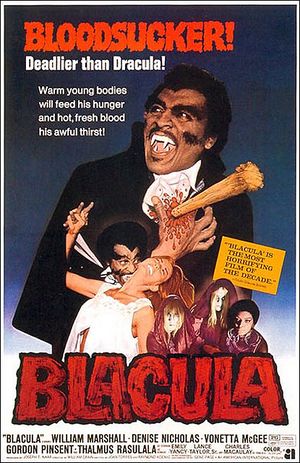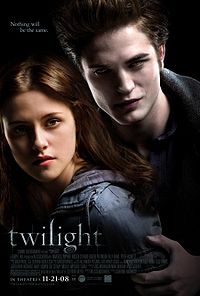Vampires
"And so the lion fell in love with the lamb"
"What a stupid lamb"
"What a sick, masochistic lion"
- [Twilight]
Vampire
A vampire is a preternatural being, supposed to seek nourishment, or do harm, by sucking the blood of persons; a man or woman abnormally endowed with similar habits.[[1]] They were, during the pre-medical enlightenment, a reflection of social anxieties and an explanation of incomprehensible deaths.

There have been many famous interpretations of vampires such as Buffy the Vampire Slayer and Blacula. Both vampire tales have racial, gendered, and sexual power structures forming controversy in each plot. The Vampire Diaries and Twilight have oppressive structures within their plot, but they also feature a "morally reformed vampire" who does not seek to harm humans (Franiuk, 2013, p.16).
The Gendered Vampire
Dracula's "Wives"
Bram Stoker's Dracula involved three female characters, who mortal society called his "wives." Though Dracula is considered deviant and evil to male mortal society, he has charm and power over the females. Once these women are lured into his life and commit to staying, they go through an incestual transition (Stevenson, 1988). "Wives" are the monogamous parter of Dracula until they fully transition into a vampire. Once they can no longer return to mortality, they become Dracula's daughters or sisters, to help and care for him. At this point he encourages them to see other people. During Mina's transition, she says to her husband “[t]hink, dear, that there have been times when brave men have killed their wives and womenkind to keep them from falling into the hands of the enemy [...] It is men’s duty towards those whom they love, in such times of sore trial!” (Stoker, 1996, p.336). She is asking her "brave" husband to stop vampires, even if it involves destroying "wives and womankind" rather than losing them to the "enemy" (Stenvenson, 1988, p.139). These women are only worth as much as their relationship to men, be it Dracula or their husband.
Gender Roles
A gender role refers to the expectations of individuals based on their gender, also known as gender stereotypes. Rather than power and domination of one gender over another, as found in Dracula, Twilight uses stereotypical gender roles to define the heterosexual relationship between the story's main characters. Edward Cullen, the "strong, dangerous, emotionally troubled vampire" and Bella Swan as the "weak, vulnerable, nurturing human" (Franiuk, 2013, p.14). Buffy the Vampire Slayer challenges these expectations by having a female protagonist as a vampire slayer. Compared to Blacula and Twilight where the female characters lack agency and control, Buffy is a solution and the embodiment of good over evil.
The Foreign Vampire

Dominant society has a tendency to categorize individuals into groups to maintain social control. In Twilight, Edward Cullen is a foreigner in the small town of Forks, Washington. No mortal suspects that he and his family deviate from the norm in ways other than their strange personalities, paleness, and their inseparable family clique, of which Bella Swan quickly becomes a part of. Him and his "siblings" are categorized as the Other by their classmates because it is the only form of social control they can apply.
Dracula was written in a time of cultural imperialism and colonial expansion; this lead to the strong suspicion of foreigners. To the mortal in the story, Dracula is not a monster, he is a foreigner. As we can see, this directly reflects the social anxieties at the time; "[t]he distinction between the moral excellence of the insiders and the physical peculiarity of the foreigner underlies the outsider's inherent danger" (Stevenson, 1988, p.142).
Interracial Sexual Competition
Interracial Sexual Competition is a concept proposed by John Allen Stevenson in A Vampire in the Mirror: The Sexuality of Dracula'. He proposed that this form of competition is central to acts of racial marginalization, specifically of men. The "brave" mortal men believe the real horror of Dracula is his adultery and his ability to turn a "good Englishwoman" away from her "own kind," her values, and her customs (Stevenson, 1988). Much like Dracula, there is also interracial Sexual Competition in Twilight. Bella Swan plays the damsel in distress as both vampire Edward Cullen and werewolf Jacob Black fight for her love. The dominance of a foreign race and culture over women has long been used as a tactic of colonization and power assertion. During the colonization of First Nation's people in North America, many white settlers had sexual relations with First Nation women as a method of assimilating them into the new dominant culture. It could be argued that the control of women leads to the control of territory. Twilight's vampires represent white settlers, intruding on First Nation (werewolf) territory- thus the treaty between the two groups for the allocation of land and, eventually, the allocation of Bella's time.
Blaxploitation
Blaxploitation films often are marginalized because of their direct contrast to whiteness and their social critique (Lawrence, 2009). Blacula is depicted as a victim after having his agency stripped away from him, Dracula, on the other hand, still possesses his agency while he attempts to take over Northern Europe. American history of slavery and the marginalization of Black communities is directly reflected in Blacula's plot. Blacula, formerly Prince Mamuwalde, was enslaved by Count Dracula in an eternity of immortality and longing for his kidnapped wife. His coffin was then sold to a couple in the United States where he was then transported and awakes after hundreds of years solitude. The white male Dracula who put Blacula in this position is considered the monster, while the racialized Blacula, though having killed for nourishment, is the victim (Lawrence, 2009).
The Sexual Vampire
"Modern vampires have a hypnotic stare that captivates the victim. Their canine teeth become prominent and their eyes turn blood red as they prepare or are compelled to feed. The teeth are used to penetrate the flesh of a victim's neck, from which the blood is then drawn" (Lucas, 2013). They procreate and find nourishment in the same action. In Twilight, the vampire protagonist struggles between his desire to drink the blood of his romantic interest and his 'love' for her (Franiuk, 2013, p.14). With that said, in this love story between a vampire and a human, the vampire can procreate through sexual intercourse which makes it unlike any other vampire plot. This story follows a clear and popular plot; a heterosexual relationship is developed by incorporating dominant and submissive roles and eroticizing aggressive male behaviour. The female, Bella, is "overcome with passion by the man's domineering behaviour and as having nothing more than her body to offer in exchange for the male hero's assistance throughout the novel" (Franiuk, 2013, p.16)).
The concept of incestual relationships occur in vampire narratives outside of gender control; the Cullens of Twilight are a family with heterosexual parents and five children. The children are in romantic relationships with each other, except for Edward who is in love with human Bella. This means that Edward's siblings are both siblings to each other as well as romantic and sexual partners. “Since all vampires are kin, they cannot simultaneously seek likeness (i.e. marry within the confines of the group) and avoid incest, as human beings do” (Stevenson, 1988, p.144).
References
Bowdre, K. (2011). Blaxploitation films of the 1970s: Blackness and genre (review). Black Camera, 3(1), 163-165.
Franiuk, R., & Scherr, S. (2013). “The lion fell in love with the lamb”. Feminist media studies, 13(1), 14-28.
Hefner, B. (2012). Rethinking blacula: Ideological critique at the intersection of genres. The journal of popular film and television, 40(2), 62-74.
Lawrence, N. (2009). Fear of a blaxploitation monster: Blackness as generic revision in AIP's film international, 7(39), 14-27.
Lucas, D. (2009, January 20). Vampires. Retrieved October 21, 2014, from http://knowledge.sagepub.com/view/time/n635.xml
Nayar, P. (2010). How to domesticate a vampire: Gender, blood relations and sexuality in Stephenie Meyer’s twilight. Nebula, 7(3), 60-76.
Stevenson, J. (1988). A vampire in the mirror: The sexuality of dracula. Modern language association, 103(2), 139-149. Retrieved October 21, 2014, from http://www.jstor.org/stable/462430.
Stoker, B. (1996). Dracula. Charlottesville, Va.: University of Virginia Library.